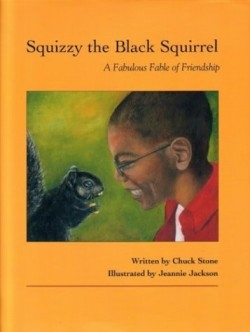Squizzy the Black Squirrel
A Fabulous Fable of Friendship
Listen to the squirrels. The bushy-tailed fellows in the park come in different colors, but don’t notice or care that there’s only one black squirrel in the neighborhood. Actually, the fact that they have individual colors has to be pointed out to the animals.
The question about being black is posed by Marcus, a warm-hearted African-American second-grader, who has been challenged by his teacher to make a new friend in the neighborhood. It seems to be a difficult task, since Marcus already knows everyone. Then he sees the black squirrel.
Marcus is intrigued. The other squirrels are red, brown, or gray. Marcus wonders if he can talk to the little fellow. The black squirrel, in an angry, squeaky voice, demands to know why the boy is hanging around his oak tree.
Marcus tells him that he thinks the squirrel is cool because he’s black, but that only annoys the creature, who shouts, “I am a SQUIRREL.” Then the squirrel, Squizzy, wants to know what is “a black.” Marcus explains that black is a color. Squizzy asks, “What is a color? Can a color gather acorns?”
Marcus tries to explain color, and Squizzy responds, explaining who he is by describing what he can do: climb trees, play, chase and have fun, eat. “Black” is just a word and “Words don’t help us squirrels gather acorns. Paws do.” In a nutshell, that is the meat of the book’s message. Color shouldn’t matter. It is what’s inside, and what people (and squirrels) do that counts.
Marcus and the squirrels become friends, and the boy knows he will have something special to share with his class.
This gentle, sometimes humorous tale is illustrated with engaging, lifelike oil paintings. The illustrator is a member of the Society of Children’s Book Writers and Illustrators. Her work for this book, which captures the meeting and ultimate friendship of boy and squirrel, was supported by a grant from the Delaware Division of the Arts.
What gives this picture book a special dimension is the author’s personal experience in the Civil Rights movement. A Tuskegee Airman in his youth, Stone, an African-American, became a noted journalist, a nationally syndicated columnist, and editor of three major black newspapers. He has taught at Harvard and other prestigious universities, served as founding president of National Association of Black Journalists, and hosted a PBS public affairs program. He teaches journalism at the University of North Carolina at Chapel Hill.
Stone’s fable of friendship teaches without preaching, the way a good fable should.
Reviewed by
Linda Salisbury
Disclosure: This article is not an endorsement, but a review. The publisher of this book provided free copies of the book to have their book reviewed by a professional reviewer. No fee was paid by the publisher for this review. Foreword Reviews only recommends books that we love. Foreword Magazine, Inc. is disclosing this in accordance with the Federal Trade Commission’s 16 CFR, Part 255.

